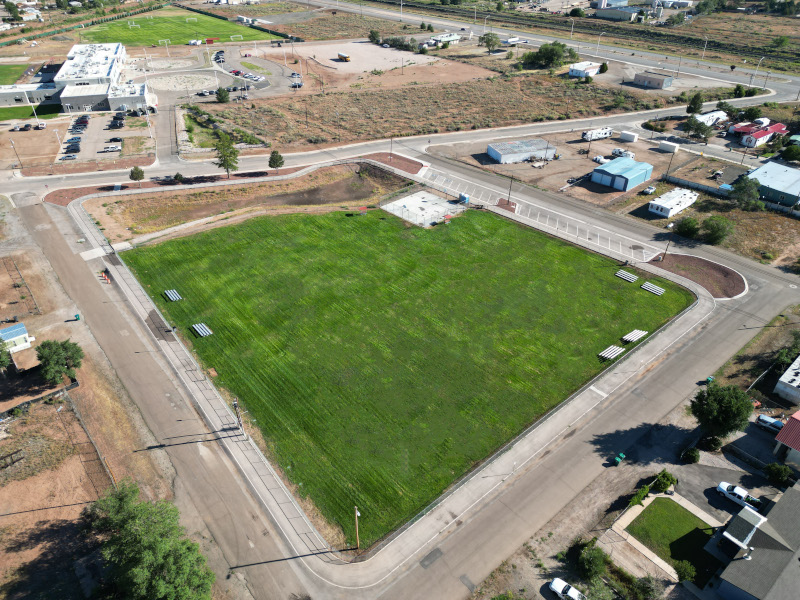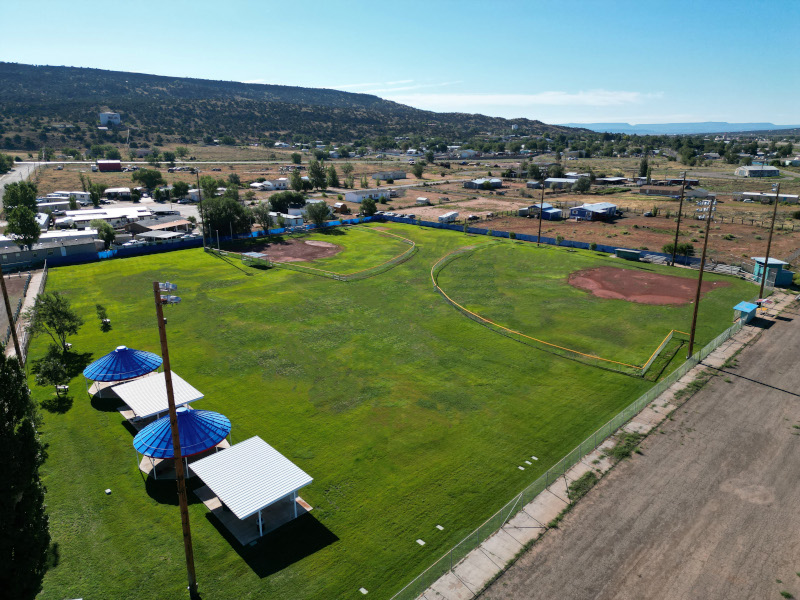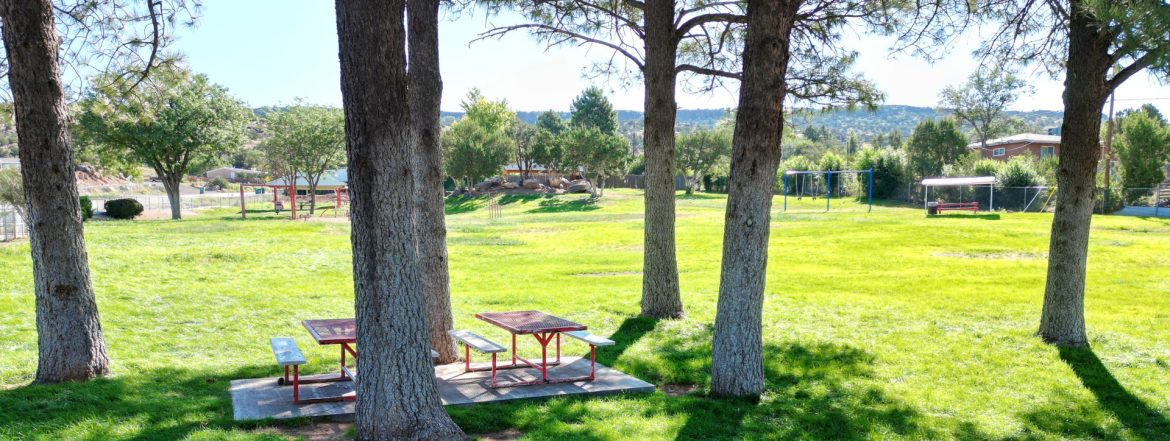Milan, New Mexico
A Village Balancing Growth and Tradition
Preparing for future growth with new infrastructure, housing, and tourism initiatives
The Village of Milan, New Mexico, proudly embraces its small-town charm while offering visitors a blend of natural beauty, recreation, and accessibility. Situated on the iconic Route 66, Milan is not just a stop along the way but a destination in itself, with its clean streets, friendly atmosphere, and proximity to outdoor attractions and key transportation routes.
“We have a small town, uh, village,” Mayor Felix Gonzales says, highlighting Milan’s intimate scale. Despite its size, Milan boasts a low crime rate and well-maintained parks, making it a safe and pleasant place for residents and tourists. “Recreation is a big thing in the village of Milan,” he adds. From the serene surroundings of Bluewater Lake to the grandeur of Mount Taylor and the Zuni Mountains, nature lovers have much to appreciate just a short drive from town.
Milan is also a hub for those traveling on historic Route 66. “We have several businesses that would cater to a tourist,” Mayor Gonzales explains. With clean streets and welcoming local businesses, visitors often find Milan to be a comfortable and convenient place to stop. The village’s location near major highways, including I-40, further enhances its accessibility. As the mayor puts it, “We have very close access to I-40,” a critical factor in drawing traffic and commerce into the area.
But Milan isn’t just a pass-through town. The village puts on a number of local events that draw in people from nearby areas. Denise Baca, who handles projects and village duties, lights up when describing these gatherings. “We have an annual pumpkin patch that we hold the weekend before Halloween every year,” she says. The event, which features free pumpkins for the kids, is a highlight of the fall season. It’s a lively, community-centered day that Baca and the village look forward to annually.
Attracting New Businesses
As Milan grows, the village leadership is actively pursuing strategies to attract new businesses and strengthen existing ones. While small in size, Milan is not passive when it comes to economic development. Thanks to proactive efforts and strategic partnerships, the village is positioning itself as a place where businesses can thrive.
“We work closely with our economic development, both statewide and locally,” says Village Manager and Finance Director Candi Williams. The village has built strong relationships with representatives from various levels of government to ensure that Milan is on the radar for new industries and investment opportunities. These connections, along with the support of the Council of Governments, create a network of resources that Milan taps into regularly to explore new opportunities for growth.
One of the village’s most ambitious projects is developing an industrial park. “We’re in the process of building an industrial park,” Williams shares. This forward-looking initiative is set to offer companies a new place to set up shop in Milan. We have all the plans, the spec buildings, design, stuff like that,” she explains. The park’s infrastructure is well underway, including a rail crossing and the first part of the roadway for phase one.

Tackling Housing Challenges and Growing the Community
As Milan seeks to expand its economic footprint, one of the village’s most pressing issues is the availability of workforce housing. Without enough homes to accommodate potential workers, the village’s efforts to attract and retain new businesses are met with added complexity. To address this, the village has taken a proactive stance, looking for innovative ways to ensure housing keeps pace with economic growth.
“We’re working on an ordinance for tiny houses,” Baca reveals, demonstrating Milan’s willingness to think outside the box when it comes to housing solutions. With limited space and a need for affordable, efficient homes, the tiny house ordinance represents a creative approach to easing the housing shortage. These smaller homes could provide quick, affordable options for workers while still maintaining the village’s charming, small-town feel.
In addition to this, Milan is actively engaging with developers to encourage the construction of affordable housing. “We did pass an ordinance that allows us to help out any developers that are interested in affordable housing,” Baca says. This measure, which was passed in February, shows how the village is working with private sector partners to ensure that the housing market evolves alongside the village’s economic needs. The village isn’t simply waiting for developers to take notice—they’re actively creating a welcoming environment for those who see the opportunity Milan presents.
Revitalizing and Preserving the Downtown Experience
Route 66 is more than just a historic highway cutting through Milan—it serves as the village’s Main Street, where local businesses cluster, and tourists often find themselves exploring a slice of small-town charm. Milan’s downtown district is humble yet inviting, with a blend of established businesses catering to locals and travelers alike.
“Our businesses down Route 66 are already established,” says Mayor Gonzales. Many small businesses play a significant role in the community, providing jobs and a sense of continuity. The mayor explains that these businesses might not be large employers but still contribute to the local economy. “It’s a very friendly, very down-to-earth, homely district,” he describes, painting a picture of a welcoming atmosphere where visitors and residents alike can feel at ease.
One of the standout attractions is Uncle Roy’s Kachina Place, a unique stop for tourists looking to connect with the region’s rich Native American culture. “They have a variety of Native American artifacts that they display,” Mayor Gonzales notes. Places like this give Milan its distinct identity—a small village offering authentic experiences tied to the area’s history and culture.
The downtown district also offers a mix of culinary options that reflect the local heritage. “We have a variety of Spanish, Mexican, and other types of food to eat in our Route 66 district,” the mayor adds. These restaurants, alongside shops like Uncle Roy’s, keep Milan’s downtown alive and engaging, drawing people in for the convenience, warmth, and personality these local establishments provide.
Walkability and Outdoor Spaces
Milan is also making strides in enhancing its walkability and promoting outdoor recreation. With Route 66 acting as a central vein for both car and foot traffic, the village has worked to ensure that both locals and visitors can move around the area comfortably.
“Our Main Street district is basically 66,” says Williams, noting that this makes it naturally walkable and bikeable for those passing through on foot or on two wheels. The village sees hikers and bicyclists on the Transcontinental Trail passing through, drawn by the ease of access along Route 66.
But the village’s attention to pedestrian safety doesn’t stop at Main Street. “We’ve put in a lot of work creating sidewalks, curbs, and gutters so that they can have safe places to walk,” Williams explains. Beyond the downtown core, Milan has invested in making its streets safer and more accessible for residents, ensuring that even the off-streets of the village offer secure paths for walking and biking.
For those seeking a more leisurely outdoor experience, Milan offers six parks with walking tracks and designated areas to enjoy nature. “One of those parks is also used as a dog park,” Mayor Gonzales mentions, emphasizing the village’s efforts to provide spaces where both people and pets can relax. These parks are a point of pride for Milan. “We get complimented on our parks all the time,” the mayor says, attributing the well-maintained spaces to the village staff’s hard work, who are dedicated to keeping the parks and Route 66 medians clean and inviting.
Infrastructure Projects
Despite so much going for it, Milan is not content with resting on its laurels. With a range of infrastructure projects currently underway, the village is making significant strides to ensure its systems can support future growth while enhancing the quality of life for its residents. From water and sewer improvements to solar lighting and road repairs, Milan is laying the groundwork for a brighter, more sustainable future.
“We have several infrastructure projects going on right now,” Baca explains, diving into the details of the village’s ambitious plans. One of the most critical aspects is improving the water system, which is an essential upgrade for ensuring continued development. “We’re replacing one of the wells and drilling a new well,” she adds, emphasizing the importance of maintaining a steady and reliable water supply as Milan grows. The village is also tackling the aging sewer system, with the full design already in place for upcoming upgrades.
These infrastructure projects extend beyond the essentials of water and sewer. Milan is also redoing several roadways, replacing bridges, and enhancing the infrastructure underneath the streets. “We have several streets under construction,” Baca notes, signaling the breadth of work being done to improve the village’s transportation network. Sidewalks are also being addressed, and all new construction is incorporating solar lighting in a nod to sustainability. “We’re trying to keep it as green as possible,” she says.

Integrating Tribal Communities in Milan
Milan’s connection with the surrounding tribal communities is historic and deeply woven into the fabric of daily life. While the village doesn’t have formal initiatives specifically targeting tribal experiences, it serves as a welcoming hub that amplifies and supports the rich cultural offerings of nearby pueblos and reservations.
“We advertise their tours,” Williams says, referring to the efforts to promote tribal tourism within the village. Milan’s businesses help drive awareness of cultural destinations like Sky City, the Zuni Pueblo, and the Navajo Nation. “We get them to get out there and view what the tribes offer,” she continues. The relationship is built on mutual respect and coordination, with Milan working closely with tribal representatives when necessary to ensure that both communities can thrive.
Tourism isn’t the only place where these communities intersect. Milan is a gathering point where tribal and non-tribal residents interact freely, whether through business or education. “No, we’re very integrated,” Williams affirms, reflecting the seamless blending of cultures that defines much of daily life in Milan. Native American culture is not peripheral—it is central to the village’s identity.
Looking Ahead: The Road to Milan’s Future
As Milan steadily grows, its leadership is laser-focused on balancing development and preserving the village’s unique small-town character. In the next three to five years, the village has big plans that hinge on expanding its housing, tourism, and industrial capabilities while maintaining the qualities that have long made Milan an inviting community.
“One of our goals is to have housing for the workforce,” Mayor Gonzales shares. This is a priority as Milan seeks to attract both businesses and the employees needed to staff them. As more companies express interest in the area, the need for workforce housing becomes more pressing. Milan’s leadership is actively working to meet that demand by planning new developments to accommodate future workers.
Another key initiative is the push to bring a motel to Horizon Boulevard, adjacent to I-40, one of the region’s busiest thoroughfares. “There’s a lot of tourists that stop by there,” Gonzales points out. The village hopes that adding lodging options will encourage visitors to stay longer and explore all Milan offers. In tandem with this, Mayor Gonzales speaks of the industrial park, saying, “We would like to have the industrial park full of tenants within the next five years.”
At the heart of these efforts is the desire to preserve Milan’s small-town feel, even as the village expands. “That’s one of the things that people always talk about—how much pride we all take in our little town,” Williams reflects. No matter how much Milan grows, the village is determined to retain the warmth and sense of community that have always been part of its charm.
AT A GLANCE
Village of Milan
What: A small but growing village focused on economic development, infrastructure upgrades, and community preservation
Where: Cibola County, New Mexico
Website: www.villageofmilan.com/



